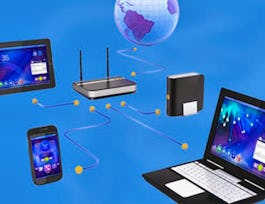This course is designed to provide a full overview of computer networking. We’ll cover everything from the fundamentals of modern networking technologies and protocols to an overview of the cloud to practical applications and network troubleshooting.


The Bits and Bytes of Computer Networking
This course is part of Google IT Support Professional Certificate
Taught in English
Some content may not be translated

Instructor: Google Career Certificates
Top Instructor
754,499 already enrolled
Included with 
Course
(47,748 reviews)
94%
Skills you'll gain
Details to know

Add to your LinkedIn profile
34 quizzes
Course
(47,748 reviews)
94%
See how employees at top companies are mastering in-demand skills

Build your Networking expertise
- Learn new concepts from industry experts
- Gain a foundational understanding of a subject or tool
- Develop job-relevant skills with hands-on projects
- Earn a shareable career certificate from Google


Earn a career certificate
Add this credential to your LinkedIn profile, resume, or CV
Share it on social media and in your performance review

There are 6 modules in this course
Welcome to the Networking course of the IT Support Professional Certificate! In the first module of this course, we will cover the basics of computer networking. We will learn about the TCP/IP and OSI networking models and how the network layers work together. We'll also cover the basics of networking devices such as cables, hubs and switches, routers, servers and clients. We'll also explore the physical layer and data link layer of our networking model in more detail. By the end of this module, you will know how all the different layers of the network model fit together to create a network.
What's included
15 videos10 readings6 quizzes2 discussion prompts1 plugin
In the second module of this course, we'll explore the network layer in more depth. We'll learn about the IP addressing scheme and how subnetting works. We'll explore how encapsulation works and how protocols such as ARP allow different layers of the network to communicate. We'll also cover the basics of routing, routing protocols, and how the Internet works. By the end of this module, you'll be able to describe the IP addressing scheme, understand how subnetting works, perform binary math to describe subnets, and understand how the Internet works.
What's included
18 videos3 readings5 quizzes1 discussion prompt
In the third module of this course, we'll explore the transport and application layers. By the end of this module, you'll be able to describe TCP ports and sockets, identify the different components of a TCP header, show the difference between connection-oriented and connectionless protocols, and explain how TCP is used to ensure data integrity.
What's included
11 videos2 readings4 quizzes1 plugin
In the fourth module of this course, we'll explore networking services. We'll learn about why we need DNS and how it works. We'll also show you why DHCP makes network administration a simpler task. By the end of this module, you'll be able to do describe how DNS and DHCP work, how NAT technologies help keep networks secure, and how VPNs and proxies help users connect and stay secured.
What's included
14 videos3 readings7 quizzes2 discussion prompts
In the fifth module of this course, we'll explore the history of the Internet, how it evolved, and how it works today. We'll understand the different ways to connect to the Internet through cables, wireless and cellar connections, and even fiber connections. By the end of this module, you'll be able to define the components of WANs and outline the basics of wireless and cellular networking.
What's included
15 videos9 readings6 quizzes1 discussion prompt
Congratulations, you've made it to the final module in the course! In the last module of this course, we'll explore the future of computer networking. We'll also cover the practical aspects of troubleshooting a network using popular operating systems. By the end of this module, you'll be able to detect and fix a lot of common network connectivity problems using tools available in Microsoft Windows, MacOS, and Linux operating systems.
What's included
18 videos6 readings6 quizzes2 discussion prompts
Instructor

Offered by
Recommended if you're interested in Networking

University of Colorado System
Why people choose Coursera for their career




Learner reviews
Showing 3 of 47748
47,748 reviews
- 5 stars
79.16%
- 4 stars
15.89%
- 3 stars
3.13%
- 2 stars
0.86%
- 1 star
0.94%
New to Networking? Start here.

Open new doors with Coursera Plus
Unlimited access to 7,000+ world-class courses, hands-on projects, and job-ready certificate programs - all included in your subscription
Advance your career with an online degree
Earn a degree from world-class universities - 100% online
Join over 3,400 global companies that choose Coursera for Business
Upskill your employees to excel in the digital economy
Frequently asked questions
Access to lectures and assignments depends on your type of enrollment. If you take a course in audit mode, you will be able to see most course materials for free. To access graded assignments and to earn a Certificate, you will need to purchase the Certificate experience, during or after your audit. If you don't see the audit option:
The course may not offer an audit option. You can try a Free Trial instead, or apply for Financial Aid.
The course may offer 'Full Course, No Certificate' instead. This option lets you see all course materials, submit required assessments, and get a final grade. This also means that you will not be able to purchase a Certificate experience.
When you enroll in the course, you get access to all of the courses in the Certificate, and you earn a certificate when you complete the work. Your electronic Certificate will be added to your Accomplishments page - from there, you can print your Certificate or add it to your LinkedIn profile. If you only want to read and view the course content, you can audit the course for free.
If you subscribed, you get a 7-day free trial during which you can cancel at no penalty. After that, we don’t give refunds, but you can cancel your subscription at any time. See our full refund policy.




